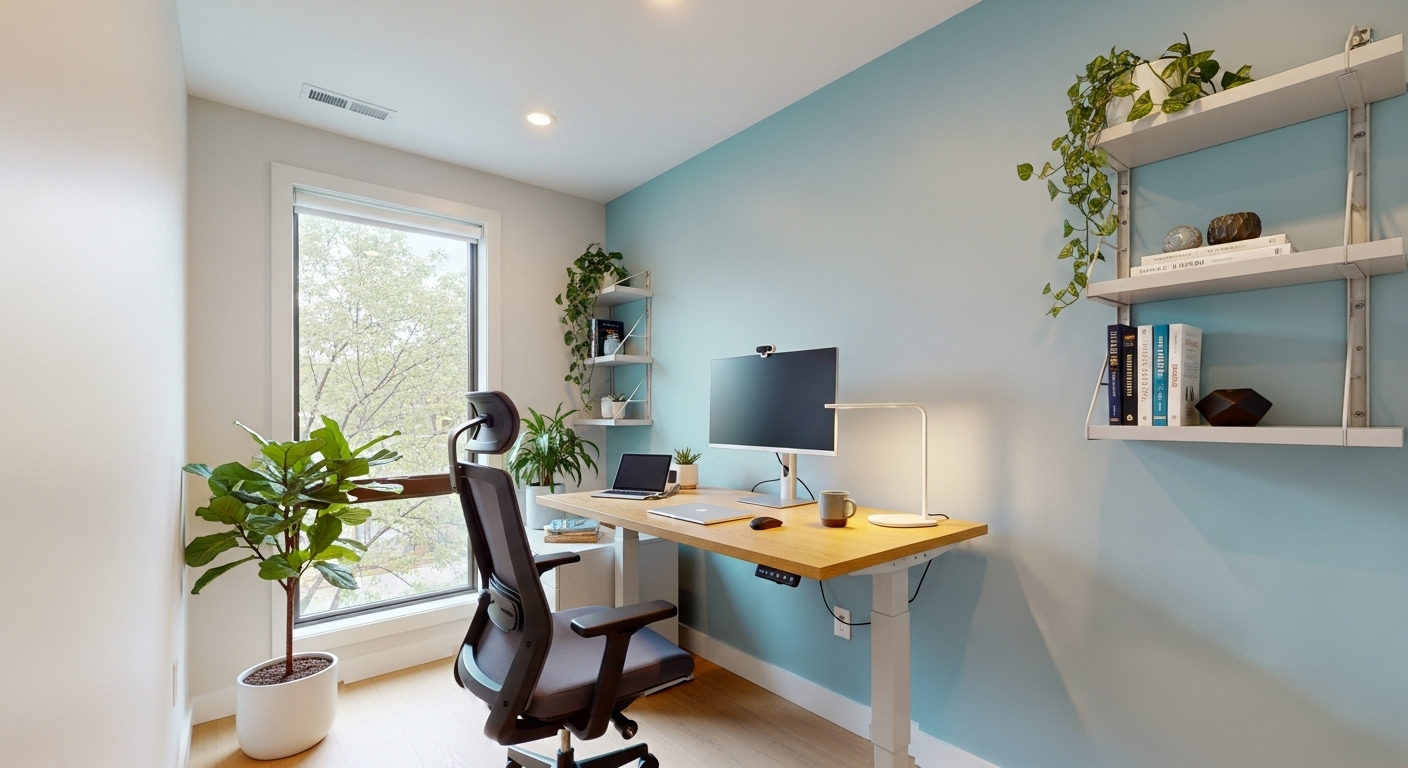The allure of a coworking space is undeniable. It offers a vibrant escape from the isolation of a home office, buzzing with the energy of ambitious professionals and the promise of serendipitous connections. Yet, this same vibrancy can become its greatest liability. The constant hum of conversations, the foot traffic, and the endless opportunities for distraction can derail even the most disciplined individuals. True productivity in a shared environment isn’t about finding a magical space devoid of interruption; it’s about intentionally engineering your own personal sanctuary within it. This requires a strategic approach that goes beyond simply putting on headphones. It involves a conscious blend of environmental selection, routine engineering, and social navigation. In this guide, we’ll explore the actionable steps you can take to move beyond the buzz, transforming your corner of a bustling hub into a fortress of focus and a launchpad for your best work. We will delve into how to choose your workspace strategically, build impenetrable routines, leverage the right technology, and master the art of being social without sacrificing your workflow.
Choosing Your Zone: Strategic Desk Selection
The spot you choose in a coworking space is the foundation of your productivity sanctuary. It’s not just about finding a place to plug in your laptop; it’s a strategic decision that influences your focus, mood, and efficiency for the entire day. The first factor to consider is traffic flow. Hot-desking near the entrance, coffee machine, or restrooms guarantees a steady stream of distractions. Instead, scout for low-traffic corners or desks along a wall. This simple act of positioning can dramatically reduce visual and auditory interruptions. Having a wall behind you also provides a psychological sense of security and control, minimizing the feeling of being constantly watched or approached from behind. Natural light is another critical element. Studies consistently show that exposure to natural light improves mood, reduces eye strain, and boosts alertness. If possible, opt for a desk near a window. However, be mindful of glare on your screen at different times of the day. Finally, consider the ‘neighborhood’. Are you sitting near a notoriously chatty team or in a designated ‘quiet zone’? Some coworking spaces are explicitly designed with different energy zones. Aligning your location with your task—for instance, using a collaborative zone for brainstorming and a quiet zone for deep work—is a powerful strategy. Don’t be afraid to move throughout the day or test different spots over a week to find the combination that truly works for you. Your ideal zone is a personal preference, but making the choice intentionally is the first step toward mastering your environment.
The Ritual Blueprint: Engineering a Productive Routine
With your physical space optimized, the next layer of your sanctuary is built with routine and ritual. Humans are creatures of habit, and creating clear start-and-end-of-day rituals can signal to your brain when it’s time to work and when it’s time to switch off. An ‘arrival ritual’ might involve more than just opening your laptop. It could be the process of getting a specific coffee, tidying your desk space, reviewing your top three priorities for the day, and putting on your noise-canceling headphones. This sequence creates a mental on-ramp to a state of focus. Similarly, a ‘departure ritual’ is crucial for work-life balance. Instead of just slamming your laptop shut, take ten minutes to review what you’ve accomplished, plan your main task for tomorrow, and neatly pack your belongings. This provides closure and prevents work from mentally spilling into your personal time. During the workday, time-blocking is an essential technique. Schedule specific blocks for deep work, shallow tasks (like email), and breaks. Crucially, you must signal these blocks to others. Headphones are the universal sign for ‘do not disturb,’ but you can also use a small, physical sign on your desk. For structuring your focus blocks, the Pomodoro Technique remains unmatched for its simplicity and effectiveness. As productivity expert Francesco Cirillo, its creator, intended, the technique is about managing energy, not just time.
“The Pomodoro Technique is a time management method based on 25-minute stretches of focused work broken by five-minute breaks. Longer breaks, typically 15 to 30 minutes, are taken after four consecutive work intervals. Each interval is known as a pomodoro, from the Italian word for tomato, after the tomato-shaped kitchen timer that Cirillo used as a university student.”
This method helps maintain high energy levels and prevents burnout in a stimulating coworking environment.
The Tech Trinity: Your Essential Productivity Toolkit
Your physical and mental strategies are powerful, but they are amplified by the right technology. In a coworking space, a curated tech toolkit is not a luxury; it’s a necessity for creating a secure and focused work bubble. The first and most critical component is what we’ll call the ‘auditory shield’: high-quality, over-ear, noise-canceling headphones. These are the single most important investment for coworking productivity. They not only block out distracting conversations and background noise but also serve as a powerful social cue that you are in deep work mode. The second piece is the ‘digital fortress’: tools for security and privacy. Coworking Wi-Fi is a shared network, making it inherently less secure than a private office or home network. A reliable VPN (Virtual Private Network) is non-negotiable. It encrypts your internet traffic, protecting sensitive client and personal data from potential threats on the network. Complementing this is a physical privacy screen for your laptop, which narrows the viewing angle so only you can see what’s on your display, safeguarding your work from prying eyes. The final component is the ‘organizational engine’: a streamlined set of software for managing your tasks and information. In a dynamic environment, your digital organization must be flawless. This means having a trusted task manager (like Todoist or Asana), a flexible note-taking app (like Notion or Evernote), and a cloud storage system (like Google Drive or Dropbox) that keeps all your files synced and accessible. This trinity of tech—shield, fortress, and engine—creates a seamless and secure workflow, allowing you to operate with confidence and focus, regardless of the chaos around you.
Social Scaffolding: Networking Without Derailing Your Day
One of the primary reasons to join a coworking space is the community. However, the social aspect is also the biggest potential threat to your productivity. The key is not to become a hermit but to build a ‘social scaffold’—a deliberate structure for your interactions. The most effective strategy is to schedule your social time. Instead of allowing impromptu conversations to break your focus at any moment, be proactive. When someone approaches you while you’re in a deep work block, have a polite-but-firm script ready. Something like, “It’s great to see you! I’m right in the middle of something, but I’m taking a coffee break at 11. Can we connect then?” This validates the other person while protecting your focus block. It transforms interruptions into scheduled connections. Another strategy is to leverage community events. Most coworking spaces host happy hours, lunches, or workshops. Participating in these designated events allows you to network efficiently without letting social interactions bleed into your work hours. It concentrates your networking efforts into specific, pre-planned times. It’s also important to be a good community member by respecting others’ focus signals. If you see someone with headphones on and deep in concentration, save your question for later or send them a Slack message. By modeling the behavior you want to see, you help cultivate a culture of mutual respect for deep work. This structured approach allows you to reap the benefits of community and collaboration without sacrificing the hours needed for concentrated effort.
Leveraging the Landscape: Maximizing Coworking Amenities
Modern coworking spaces are designed as ecosystems, not just open-plan offices. The various amenities they offer are not just perks; they are strategic tools you can use to manage your productivity and well-being. Failing to leverage this landscape means you’re missing out on a key advantage of the coworking model. For instance, the ubiquitous phone booth is your best friend for any call or virtual meeting. Taking calls at your desk not only distracts everyone around you but also forces you to be guarded in your conversation. Stepping into a phone booth provides privacy and soundproofing, allowing you to speak freely and professionally while keeping the main work area quiet. Similarly, underutilized meeting rooms can be booked for more than just team huddles. If you have a project that requires intense, uninterrupted concentration for two hours, booking a small meeting room for yourself can be a game-changer. It creates a temporary private office, removing you entirely from the open floor’s distractions. Even the lounge and kitchen areas have a strategic purpose beyond sustenance. Use them for your planned breaks. Physically removing yourself from your desk and changing your scenery helps your brain reset and decompress more effectively than just scrolling through your phone at your workstation. By viewing the entire coworking space as a suite of tools—phone booths for privacy, meeting rooms for focus, lounges for rest—you can orchestrate your day for peak performance, matching your environment to your task.
Mind Over Matter: The Psychology of Shared Space Productivity
Ultimately, sustained productivity in a shared space is a mental game. Mastering the external environment is only half the battle; you must also manage your internal landscape. One powerful psychological phenomenon at play is the ‘audience effect,’ or social facilitation. Research suggests that the mere presence of others can improve performance on simple or well-rehearsed tasks. You can leverage this by saving your more routine work, like responding to emails or organizing files, for times when the space is busiest. The ambient energy can actually make you more efficient with these tasks. The flip side of this is learning to erect mental boundaries. It’s easy to feel a sense of ‘FOMO’ (Fear of Missing Out) when you hear laughter from the kitchen or a group making plans for lunch. You must train your brain to acknowledge these sounds without letting them hijack your attention. Mindfulness practices can be incredibly helpful here, teaching you to observe distractions as passing clouds rather than urgent calls to action. A crucial part of this is overcoming ‘productivity guilt.’ You don’t have to be ‘on’ for eight straight hours. Honoring your scheduled breaks and allowing yourself to be social during those times is part of the system. Trying to power through when your brain is fried is counterproductive. Giving yourself permission to use the social aspects of the space strategically makes your focused time more effective and sustainable in the long run. By understanding and working with these psychological forces, you can achieve a state of relaxed focus, becoming the calm center of your bustling work environment.
In conclusion, thriving in a coworking space is an art of intentionality. It’s about moving from a passive participant in a noisy environment to an active architect of your personal productivity sanctuary. This transformation doesn’t hinge on a single hack, but on a holistic system that integrates your physical space, daily routines, technological tools, and social strategies. By strategically selecting your zone, you lay the physical groundwork for focus. By engineering powerful rituals, you create the mental on-ramps for deep work. Equipping yourself with the tech trinity of a noise-canceling shield, a digital security fortress, and an organizational engine allows you to operate with seamless efficiency. Furthermore, building a social scaffold enables you to enjoy the community benefits without the associated productivity costs, while leveraging the full landscape of amenities turns the entire space into your personalized toolkit. Ultimately, mastering the psychology of the shared environment allows you to find your flow amidst the buzz. Productivity in a coworking space is not about isolation; it’s about creating a controllable, personal bubble that allows you to engage with the vibrant community on your own terms. By implementing these strategies, you can harness the energy of the space to fuel your work, rather than letting it become a source of distraction.





